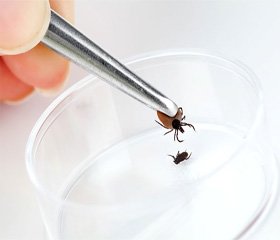Журнал «Здоровье ребенка» 4 (55) 2014
Вернуться к номеру
Lyme disease: diagnosis, therapy and prophylaxis in children (III part)
Авторы: V.V. Mavrutenkov - Dnepropetrovsk medical academy of Healthcare Ministry of Ukraine
Рубрики: Педиатрия/Неонатология
Разделы: Справочник специалиста
Версия для печати
Lyme disease in children, laboratory diagnosis, therapy, prophylaxis.
Polymorphism of clinical signs of B. burgdorferi, s. l. infection requires obliged laboratory verification of the clinical diagnosis of tick-born borreliosis. Exclusion is ring-shaped erythema ≥ 5 cm in size, which develops within a month after Ixodes tick bite, which does not require obliged laboratory confirmation of B. burgdorferi, s. l. infection presence. In spite of the fact that B. burgdorferi, s. l. infection determination includes both classical (obtaining culture and direct microscopy) and “modern” (immunochemical analysis and molecular biological tests) methods of diagnosis, in clinical practice the methods are used which are revealing exclusively anti-borrelia antibodies with the method of immune enzyme analysis (IEA) or immunoblotting (IB). Currently in laboratory practice serological diagnosis of B. burgdorferi, s. l. infection is performed step-wise with the usage of methods of immunochemical analysis: 1st step – revealing of specific antibodies in blood with IEA method, 2nd step – confirming specificity of revealed antibodies with reference test by IB method Western-blot. Necessity of reference test with usage of IB is based on the possibility of false-positive results when evaluating with IEA. It should be stressed that cases of specific IgM persistence in blood serum without seroconversion to IgG should be considered as false-positive results. Reasons of this pattern are not clearly understood. Routine usage of IB method for diagnosis of Lyme-borreliosis (LB) is not recommended due to high costs. Western-blot method has high sensitivity and specificity, it reveals specific antibodies to separate antigens (proteins) of B. burgdorferi s.l., as well as to certain degree it allows differentiate primary infection and reinfection and to predict term of infection. For diagnosis of neuroborreliosis (NB), which develops at the early dissemination stage of the disease, it is definitely required to detect anti-borrelia IgG in cerebro-spinal fluid. Considering not trivial clinical interpretation of serological results, none of the markers, including blood antibody titer to antigen VlsE, can be considered the indicator of B. burgdorferi, s. l. infection activity. So, in Europe from 5% till 20% of human population contains antibodies to B. burgdorferi s.l., without any clinical signs of LD. So, determination of specific Ig in blood serum is not the absolute provement of B. burgdorferi, s. l. infection activity, serological investigations are not used for control of therapy efficacy (evaluation of causative agent eradication), method of IB does not allow to identify genomic kind of B. burgdorferi s.l., which determines particularities of clinical signs of LD. Alternative methods of laboratory diagnosis of LD, such as: 1) significance of lymphocyte transformation test; 2) significance of cystic forms of B. burgdorferi s. l.; 3) visual contrast sensitivity test are not recommended for clinical practice as being inadequate to principles of evidence-based medicine. As well as it is not recommended to rely on investigations of removed from human body Ixodes tick, infected with parasite B. burgdorferi s. l.. Currently 40 years history of antibacterial therapy of LD is well determined both for children and adults. Basic therapy for LD for children older 8 years and adults is doxycycline (D). In cases of children younger than 8 years, pregnant, and patients with NB, β-lactame antibiotics are recommended (amoxicillin or ceftriaxone). Length of antibacterial therapy is determined by the stage of LD. Rational antibacterial therapy allows to eradicate infection of B. burgdorferi s. l. in majority of children and adults. There are three main approaches of B. burgdorferi s. l. infection prophylaxis: vaccination, post-exposure prophylaxis and avoidance of contacts with ticks. Immunoprophylaxis did not find practical usage and the company Smith Kline Beecham stopped producing the vaccine LYMErix®. Regarding post-exposure prophylaxis of B. burgdorferi, s. l. infection, according to recommendations of IDSA, adults and children ≥8 years should be given once doxycycline in dosage 200 mg and 4 mg/kg respectively (not more than 200 mg), with condition: 1) infection of Ixodes ticks is ≥ 20% in the area of human contact with the parasite; 2) the tick was adherent to skin ≥ 36 hours; 3) therapy is started within 72 hours after parasite removal. For prophylaxis of tick attack it is necessary to perform the following: regular examination of clothes and skin, timely and correct removal of adherent ticks, usage of protective clothes treated with repellents during staying in dangerous nature places.

